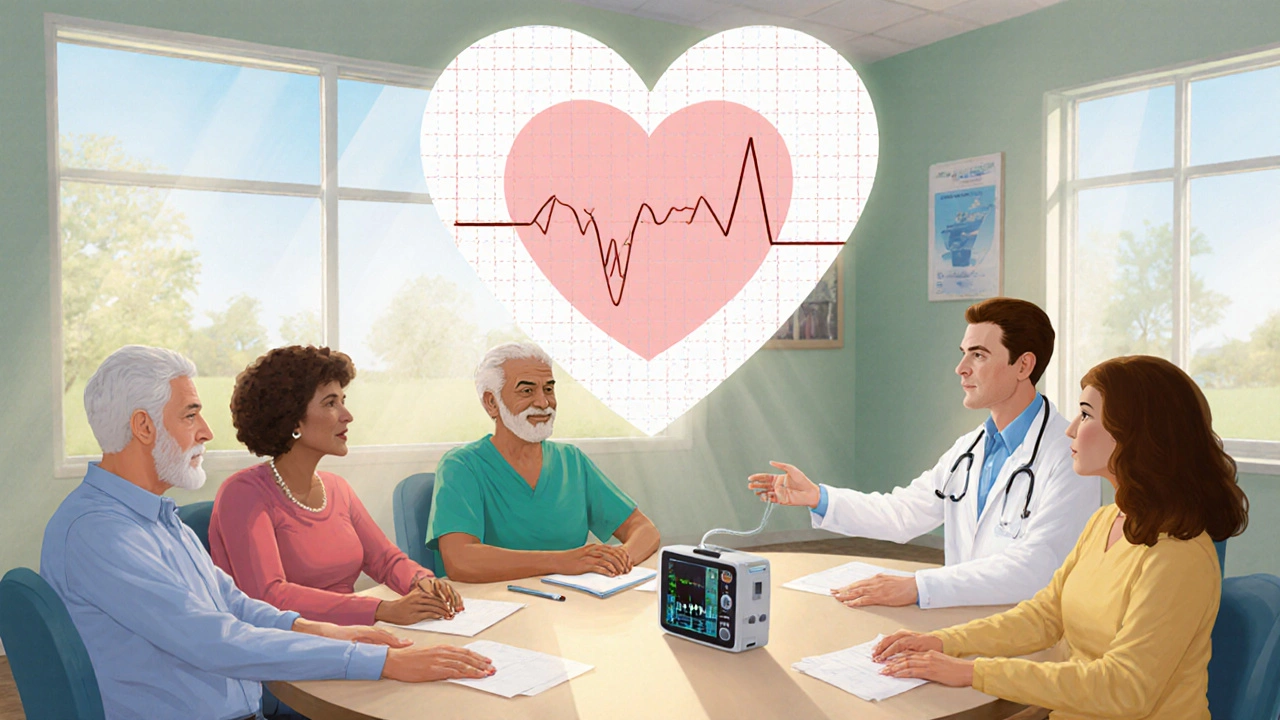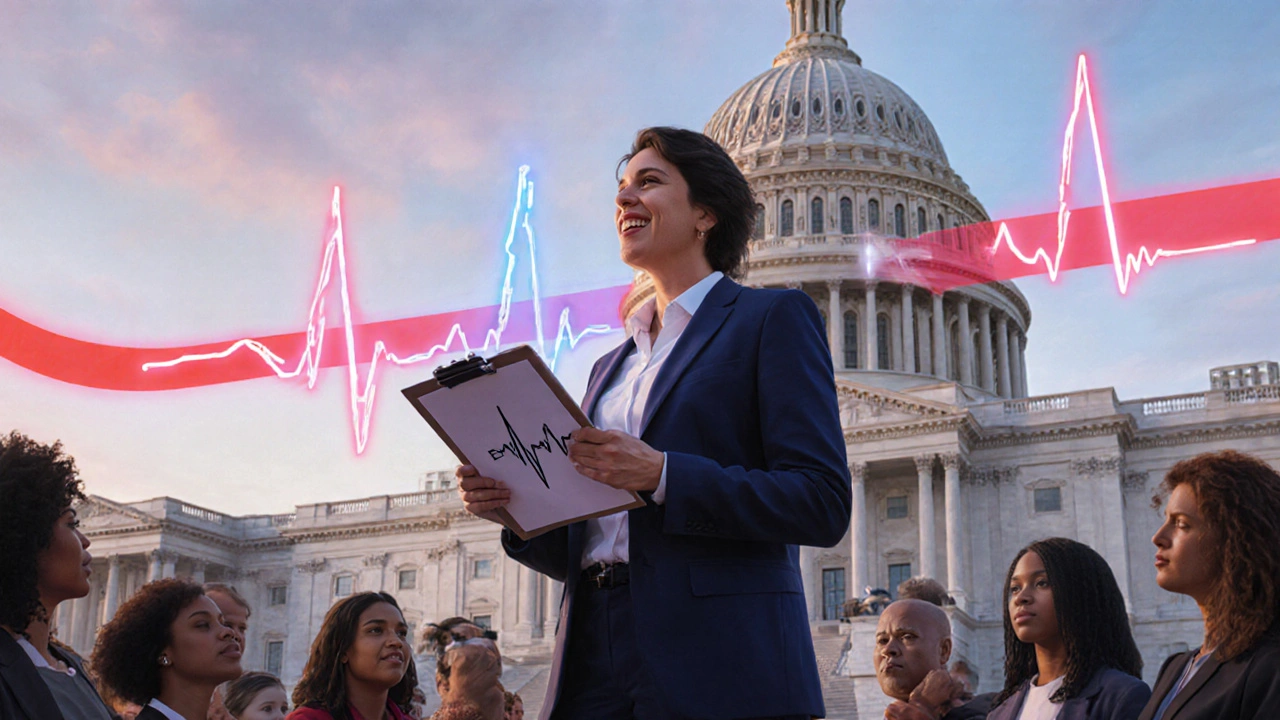
Arrhythmia Care & Advocacy Guide
This interactive guide helps you understand important aspects of arrhythmia care and how to advocate effectively for yourself or a loved one.
Checklist for Effective Arrhythmia Advocacy
Your Advocacy Progress
Quick Facts About Arrhythmias
- Approximately 3% of adults worldwide live with arrhythmias.
- One in 33 adults will experience an arrhythmia by age 70.
- Arrhythmias can be managed through medication, devices, or lifestyle changes.
- Patient advocacy improves treatment adherence and reduces emergency visits.
Common Treatment Options
- Medication: Antiarrhythmic drugs or anticoagulants
- Pacemaker: For slow heart rhythms
- ICD: For life-threatening fast rhythms
- Cardiac Ablation: To destroy abnormal tissue causing irregular rhythms
When a loved one receives an arrhythmia diagnosis, the medical jargon can feel overwhelming. That's where patient advocacy the organized effort to represent patients' needs, preferences, and rights within the healthcare system steps in. By giving a voice to the community, advocates help turn complex treatment pathways into understandable, actionable steps.
Quick Takeaways
- Arrhythmias affect roughly 3% of adults worldwide, and many go undiagnosed.
- Effective advocacy improves treatment adherence, reduces emergency visits, and speeds up access to specialist care.
- Collaborating with cardiologists, device manufacturers, and policymakers creates a safety net for patients.
- Patient support groups provide emotional relief and practical tips that clinicians often miss.
- Advocacy efforts can influence research funding and the development of clearer clinical guidelines.
What Exactly Is Patient Advocacy?
At its core, patient advocacy means speaking up for the interests of those living with a health condition. In the arrhythmia world, this includes helping patients navigate appointments, understand diagnostic results, and weigh treatment options like medication versus device implantation. Advocates can be family members, trained volunteers, or professionals who specialize in guiding patients through the maze of cardiology care.
Key attributes of effective advocacy are:
- Empathy: Listening to concerns and acknowledging fear.
- Knowledge: Staying current on guidelines from bodies such as the American Heart Association.
- Connectivity: Linking patients with cardiologists, support groups, and reliable online resources.
Understanding the Arrhythmia Landscape
Arrhythmia-irregular heart rhythm a condition where the heart beats too fast, too slow, or erratically-covers more than 150 distinct disorders. The most common forms include:
- Atrial fibrillation (AFib): A chaotic rhythm in the upper chambers, responsible for roughly 15% of strokes.
- Ventricular tachycardia: A rapid beat originating in the lower chambers, often life‑threatening.
- Bradyarrhythmias: Slow rhythms that may require a pacemaker.
Recent data from the Global Heart Rhythm Registry (2024) show that 1 in 33 adults will experience an arrhythmia by age 70. Early detection usually relies on an electrocardiogram (ECG) a quick, non‑invasive test that records the electrical activity of the heart performed in primary care or emergency settings.
Why Advocacy Changes the Care Journey
Imagine a patient who learns they have AFib during a rushed emergency visit. Without a clear explanation, they may leave the hospital confused about medication, lifestyle changes, and follow‑up appointments. An advocate can bridge that gap by:
- Providing a plain‑language summary of the ECG findings.
- Scheduling a timely consultation with a cardiologist a doctor specialized in heart disease, especially rhythm disorders who can discuss anticoagulation therapy.
- Explaining the pros and cons of an implantable cardioverter defibrillator (ICD) a device that monitors heart rhythm and delivers a shock if a dangerous arrhythmia occurs versus a pacemaker.
Studies from the European Society of Cardiology (2023) reveal that patients who receive structured advocacy support have a 22% lower rate of unplanned hospital readmissions within 30 days.

Building Effective Patient Support Networks
Support groups are more than just meeting rooms. They act as information hubs, emotional shelters, and incubators for community‑driven research ideas. A well‑run patient support group a gathering-online or offline-where individuals share experiences, resources, and encouragement typically offers:
- Monthly Q&A sessions with heart rhythm specialists.
- Peer‑led workshops on using wearable rhythm monitors.
- Guides on navigating insurance coverage for devices like ICDs and pacemakers.
In Australia, the Heart Rhythm Australia Foundation reported a 15% increase in medication adherence among members who attended regular peer‑education events.
Influencing Policy and Research
Advocacy doesn't stop at the bedside. Collective voices can shape national health policy, funding allocations, and research priorities. For example, the healthcare policy governmental rules and programs that determine how medical services are delivered and financed in Canada was recently updated to include mandatory coverage for home‑based ECG monitoring for high‑risk arrhythmia patients-an outcome driven by organized patient coalitions.
On the research front, patient‑led registries have provided real‑world data that traditional trials miss. One Australian registry, started by arrhythmia advocates in 2022, contributed over 5,000 data points that helped refine the criteria for ICD implantation in patients with non‑ischemic cardiomyopathy.
Practical Steps for Patients, Families, and Volunteers
If you or someone you care for has been diagnosed with an arrhythmia, here’s a simple action plan:
- Gather the basics: Request a copy of the ECG report and ask the cardiologist to explain the rhythm type in plain language.
- Identify a champion: Choose a family member or trained volunteer to act as the point person for appointments, medication lists, and follow‑up reminders.
- Join a support group: Look for local chapters of national arrhythmia societies or online forums with verified moderators.
- Ask about lifestyle tweaks: Simple changes-reducing caffeine, managing stress, and maintaining a healthy weight-can lower AFib episodes.
- Stay informed on guidelines: Keep an eye on updates from the American Heart Association or the European Society of Cardiology.
- Advocate for coverage: If insurance hesitates on a device, compile supporting letters from the cardiologist and any support‑group endorsements.
Remember, advocacy is a two‑way street. While you push for better care, clinicians also benefit from patient insights that improve treatment protocols.
Common Pitfalls and How to Avoid Them
Even well‑meaning advocates can hit snags. Typical mistakes include:
- Overloading patients with medical jargon: Keep explanations concise; use analogies like "the heart’s electrical system is a city’s traffic lights".
- Relying on a single information source: Cross‑check advice with at least two reputable organizations.
- Neglecting mental health: Arrhythmia anxiety is real; integrate counseling referrals into the support plan.
Addressing these early keeps momentum going and builds trust within the community.
Frequently Asked Questions
What is the difference between a pacemaker and an ICD?
A pacemaker corrects slow heart rates by delivering small electrical impulses. An ICD monitors for dangerous fast rhythms and can deliver a shock to restore normal rhythm. Both are implanted under the skin, but their therapeutic goals differ.
How can I find a qualified arrhythmia specialist?
Look for cardiologists with board certification in electrophysiology, or whose practice lists "heart rhythm disorders" as a focus. Hospital websites often include physician bios and patient satisfaction scores.
Is it safe to use wearable heart monitors for arrhythmia detection?
Yes, devices like the Apple Watch and KardiaMobile have FDA clearance for detecting atrial fibrillation. They are useful for spotting patterns but should not replace a medical‑grade ECG for definitive diagnosis.
Can patient advocacy influence insurance decisions?
Absolutely. When advocates submit detailed medical letters, evidence of necessity, and support group endorsements, insurers are more likely to approve costly treatments like ICDs or ablation procedures.
What lifestyle changes help control atrial fibrillation?
Limiting alcohol, reducing caffeine, maintaining a healthy BMI, regular aerobic exercise, and managing stress through meditation or yoga have all been linked to fewer AFib episodes.

Next Steps for the Arrhythmia Community
Advocacy thrives on momentum. Consider forming a local coalition that meets quarterly to review new guidelines, share success stories, and plan outreach events. Reach out to university research centers to offer patient perspectives for upcoming clinical trials. The more you speak, the louder the collective voice becomes, and the better the healthcare system can adapt to the real‑world needs of people living with arrhythmias.
7 Comments
Write a comment
More Articles

Low Density Living and Lower Crime Rates: Why Space Matters
Explore how low density residential layouts influence crime rates, the role of social cohesion, design strategies, and policy tools that make neighborhoods safer.

AstraZeneca Seroquel Sales Soar in 2021 as Revenue Peaks
AstraZeneca's financial performance has been notably punctuated by the success of Seroquel, its flagship product, securing a top revenue spot in 2021 with impressive growth outlined in their recent report. This shift underscores pivotal dynamics within the pharmaceutical industry, as AstraZeneca navigates through acquisitions, legal settlements, and expands its sustainability strategies under new leadership.

Revitalize Your Health with the Magic of European Mistletoe – Nature's Best-Kept Secret
In my latest blog, I delve into the sheer magic of European Mistletoe, nature's best-kept secret for revitalizing health. I was amazed to uncover a host of benefits from this humble plant, including boosting immune function and aiding in cancer treatment. I've also found out that it's been used for centuries in Europe for various medicinal purposes. It's incredible how this underestimated plant can be a game-changer for our well-being. So, join me as I explore and share the powerful benefits of the European Mistletoe for your health.

Hutchins Harbin
September 29, 2025 AT 12:44When I first heard the term 'arrhythmia' I pictured my heart racing like a drum solo at a rock concert. Turns out the reality is a lot quieter, but just as unsettling when the rhythm goes off‑beat. I've seen friends scramble for answers because nobody gave them a straightforward roadmap. That’s why having a dedicated advocate who can translate ECG jargon into plain English can be a game‑changer. If you can bridge that gap early, you save weeks of confusion and potentially avoid an emergency room bounce‑back.